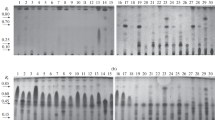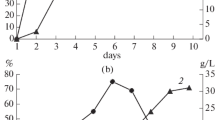Abstract
Four isolates ofPestalotiopsis, viz.P. gracilis, P. paeoniae isolates I and II, andP. royenae were isolated from the leaf spots ofAchras sapota, Anona squamosa, Syzygium cumini andCarissa congesta respectively. Studies on the nutrition of the isolates were carried out in liquid basal meduim in stationary cultures. Preliminary experiments had shown that a pH of 5.5 and a temperature of 25° C± 1° C were the most suitable for the growth of the present organisms. The growth response of the various species, as judged by their mycelial dry weight on 26 different carbon sources was studied.
Among the pentoses, D-xylose supported poor growth of all the four isolates whereas L-arabinose and L-rhamnose were as good as glucose in efficiency, or occasionally better. Among the hexoses, D-fructose and D-mannose were superior to glucose (except forP. royenae). Galactose and L-sorbose were poor sources, the latter being poorest among all the carbohydrates used in this study. The disaccharides were generally superior to glucose except lactose which was poor. AlsoP. royenae had slighthly inferior growth on trehalose than on glucose. Maximum growth, among disaccharides, was attained on cellobiose. The nutritional value of trisaccharide, raffinose, was maximum for all butP. royenae which too grew better on it than on glucose. The three polysaccharides, viz. soluble starch, dextrin and inulin were much superior than glucose except forP. royenae. Generally sugar alcohols were equal to or better than glucose in efficiency. Glycerol, however, was a very poor source. The acids supported very poor growth of all the isolates.
Similar content being viewed by others
References
Agarwala, R. K. (1955) D. Phil. Thesis, University of Allahabad, India.
Bacon, J. S. D. &D. J. Bell (1953)Jr. Chem. Soc. (London): 2508–2530.
Bhargava, S. N. (1962) D. Phil. Thesis, University of Allahabad, India.
Bhargava, S. N. &Tandon, R. N. (1964)Mycopath. et Mycol. appl. 24:156–162.
Bilgrami, K. S. &Tandon, R. N. (1957)Proc. Nat. Acad, Sci. India, 27B:196–203.
Bilgrami, K. S. (1962). D. Sc. Thesis, University of Allahabad, India.
Bilgrami, K. S. (1963)Proc. Nat. Acad. Sci. (India), B.33 IV:547–551.
Bilgrami, K. S. (1964)Flora Bd. 154, S.81–88.
Chandra, S. (1961) D. Phil. Thesis, University of Allahabad, India.
Cochrane, V. W. (1958) Physiology of fungi. John Wiley and Sons. Inc. New York.
Ehrensvard, G. (1955)Exp. Cell. Res. Suppl. 3:102–109.
Fergus, C. L. (1952)Mycologia, 44:183–199.
Ghosh, A. K. (1964) D. Phil. Thesis, University of Allahabad, India.
Gilpin, R. H. (1954)Mycologia, 46:702–707.
Grewal, J. S. (1954) D. Phil. Thesis, University of Allahabad, India.
Hall, A. M. (1959)Trans. Brit. Mycol. Soc. 33:132–141.
Lal, B. &Tandon, R. N. (1964)Proc. Nat. Acad. Sci. (India) 34(B):463–466.
Leaphart, C. D. (1956)Mycologia 48:25–40.
Lilly, V. G. &Barnett, H. L. (1951) Physiology of fungi. Mc Graw Hill Book Co. Inc., New York.
Lilly, V. G. &Barnett, H. L. (1953)Bull. W. Virginia Agric. Expt. Sta. 362 T.
Lilly, V. G. &Barnett, H. L. (1956)Amer. J. Bot. 43:709–714.
Marsden, D. H. (1954)Mycologia 46:161–183.
Mathur, R. S., Barnett, H. L. &Lilly, V. G. (1950)Phytopath. 40:104–114.
Misra, A. P. &Mukherjee, A. K. (1962)Indian. Phytopath. 15:211–215.
Misra, A. P. &Mahmood, M. (1960)Indian. Phytopath. 13:12–17.
Mitra, S. K. &Tandon, R. N. (1966)Phytopath. Z. 55:15–19.
Perlman, D. (1948)Amer. J. Bot., 35:36–41.
Pisano, M. A. &Plucker, A. F. (1958)Mycologia, 50:223–228.
Prasad, S. S. (1963) D. Phil. Thesis, Bihar University, India.
Ramakrishnan, T. S. (1941)Proc. Indian. Acad. Sci. B, 14:395–411.
Sakai, R. (1959)Nat. Agric. Expt. Sta. Res. Bull. No. 47.
Schade, A. L. (1940)Amer. J. Bot. 27:376–384.
Schade, A. L. &Thimann, K. V. (1940)Amer. J. Bot. 42:379–384.
Shirakawa, H. S. (1955)Amer. J. Bot. 42:379–384.
Srivastava, H. P. (1965) D. Phil. Thesis, University of Allahabad, India.
Steinberg, R. A. (1935)Bull. Torrey Bot. Club. 63:81–90.
Steinberg, R. A. (1939)J. Agr. Res. 59:749–763.
Subramanian, S. (1961)Proc. Indian. Acad. Sci., 54:295–305.
Taber, W. A. &Vining, L. C. (1959)Canad. J. Microbiol. 5:513–526.
Tamia, H. (1932)Acta Phytochim. (Japan) 6:1–129.
Tanaka, H. (1956)Pflanzenkrankheiten, 5:165–170.
Tandon, M. P. (1950), D. Phil. Thesis, University of Allahabad, India.
Tandon, R. N. &Agarwala, R. K. (1956)Proc. Indian. Acad. Sci., 43: B.1–8.
Tandon, R. N. &Bilgrami, K. S. (1957)Proc. Nat. Acad. Sci., 27 B:96–105.
Tandon, R. N. &Bilgrami, K. S. (1957a) Ibid. 27 B:196–203.
Tandon, R. N. &Bilgrami, K. S. (1957b)Proc. Indian. Acad. Sci. 46:274–284.
Tandon, R. N. &Bilgrami, K. S. (1958)Proc. Nat. Inst. Sci. (India) 24:118–124.
Tandon, R. N. &Bilgrami, K. S. (1959) Ibid.Proc. Nat. Inst. Sci. (India) 25:138–142.
Tandon, R. N. &Bhargava, S. N. (1960)Proc. Nat. Acad. Sci. (India) B. 30:257–265.
Tandon, R. N. &Bhargava, S. N. (1962)Lloydia, 25:167–171.
Tandon R. N. &Mitra, S. K. (1963)Proc. Nat. Acad. Sci. (India) B, 33 IV:583–590.
Tatum, E. L., Baratt, R. W. &Cutter, V. M. (1949)Science 19:509–511.
Thind, K. S. &Randhawa, H. S. (1957)Proc. Nat. Acad. Sci. (India) 27:47–53.
Tochinai, Y. (1926)J. Coll. Agric. Sappora, 14:171–236.
Trechow, C. (1944)Dansk Bot. Arkiv 11(6):1–180.
Author information
Authors and Affiliations
Rights and permissions
About this article
Cite this article
Dube, H.C. Studies on the nutrition of the genus pestalotiopsis. Mycopathologia et Mycologia Applicata 44, 183–191 (1971). https://doi.org/10.1007/BF02051887
Accepted:
Issue Date:
DOI: https://doi.org/10.1007/BF02051887




